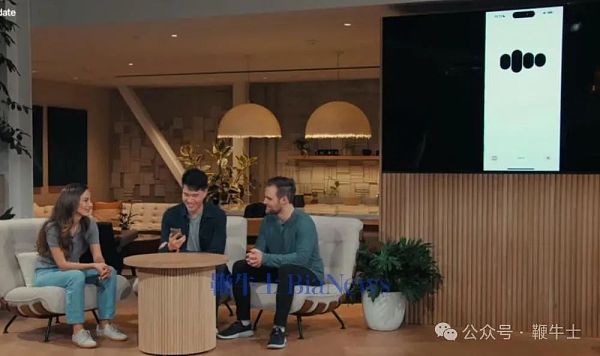Source: Bianniushi
On May 14, ChatGPT is about to become more useful.
OpenAI announced its latest artificial intelligence large language model on Monday, which it said will make ChatGPT smarter and easier to use.
The new model, called GPT-4o, is an updated version of the previous generation GPT-4 model launched by the company more than a year ago. The model will be open to free customers, meaning that anyone can access OpenAI's most advanced technology through ChatGPT.
According to the company's demonstration on Monday, GPT-4o will effectively turn ChatGPT into a digital personal assistant that can have real-time voice conversations. It is also able to interact using text and vision, which means it can view screenshots, photos, documents or charts uploaded by users and have conversations about them.
OpenAI Chief Technology Officer Mira Murati said that the updated version of ChatGPT will now also have a memory function, which means it can learn from previous conversations with users and can perform real-time translation.
“This is the first time we’ve really taken a big step forward in ease of use,” Murati said during a live demonstration at the company’s San Francisco headquarters. “The interaction becomes much more natural and much easier.”

The new release comes as OpenAI seeks to stay ahead of the increasingly fierce artificial intelligence arms race. Rivals including Google and Meta have been working to build increasingly powerful large language models that power chatbots and can be used to bring AI technology to a variety of other products.
The OpenAI event comes a day before Google’s annual I/O developer conference, where the company is expected to announce updates to its Gemini AI model.
Like the new GPT-4o, Google’s Gemini is multimodal, meaning it can interpret and generate text, images, and audio.
OpenAI’s update also comes ahead of an expected AI announcement at Apple’s Worldwide Developers Conference next month, which could include new ways to incorporate AI into the next iPhone or iOS version.
Meanwhile, the latest GPT version could be a boon for Microsoft, which has invested billions of dollars in OpenAI to embed its AI technology into its own products.
OpenAI executives demonstrated voice conversations with ChatGPT to get real-time instructions for solving math problems, read bedtime stories and get coding advice.
ChatGPT is able to speak in a natural, human-sounding voice as well as a robotic voice, and can even sing some responses. The tool is also able to look at images of charts and discuss them.
They also demonstrated models that detect user emotions; at one point, it was able to hear an executive’s breathing and encourage him to calm down.
“You’re not a vacuum cleaner!” ChatGPT’s female voice (which sounds very similar to Scarlett Johansson’s digital companion in the 2013 film Her) jokingly tells the staff.
ChatGPT is also capable of conducting conversations in multiple languages with automatic translation and responses. According to OpenAI, the tool now supports more than 50 languages.
“The new voice (and video) modes are the best computer interfaces I’ve ever used,” OpenAI CEO Sam Altman said in a blog post following the announcement. “It feels like the AI in the movies; I’m still a little surprised it’s real. It turns out that achieving human-level response times and expressiveness is a sea change.”
Murati said OpenAI will launch a ChatGPT desktop app with GPT-4o capabilities, giving users another platform to interact with the company’s technology.
GPT-4o will also be available to developers who want to build their own custom chatbots from OpenAI’s GPT store, which is also now available to non-paying users.
The updated technology and features will be rolled out to ChatGPT in the coming months. Free ChatGPT users will have a limited number of interactions with the new GPT-4o model before the tool automatically reverts to relying on the older GPT-3.5 model; paid users will have access to a greater number of messages with the latest model.
OpenAI is making many of the previously subscription-only features available to ChatGPT’s free users, with the biggest being the ability to browse its GPT store and use custom bots, OpenAI CTO Mira Murati said during the company’s spring update livestream today.
The company also announced today’s update in a blog on its website.
Just four months ago, on January 10, the company opened up its GPT store to paid subscribers. The store allows ChatGPT Plus subscribers to create their own chatbots, called GPTs, and share them. Some of the popular bots currently include an image-generating bot, a chatbot called Consensus designed to help scientific research, and a logo-making bot.

OpenAI said it will offer GPT builders a participation-based revenue-sharing program, which it began testing in March. But because the feature is limited to paying ChatGPT users, the bot’s audience is limited.
OpenAI also enables free users to upload files and photos for summarization and analysis, search the web with ChatGPT, and use GPT-4 to store previous chats, all of which were previously subscription-locked.
OpenAI says more than 100 million people are already using ChatGPT.
But the updated ChatGPT experience — and the ability to interact with it through improved voice conversations on desktop — could give more people a reason to use its technology.
The moves come as Google and Meta integrate artificial intelligence into more widely used consumer products like Instagram and Google Assistant, potentially making those companies’ technology more widely and easily accessible.
 JinseFinance
JinseFinance
 JinseFinance
JinseFinance JinseFinance
JinseFinance JinseFinance
JinseFinance WenJun
WenJun Kikyo
Kikyo Weatherly
Weatherly JinseFinance
JinseFinance JinseFinance
JinseFinance Jixu
Jixu JinseFinance
JinseFinance